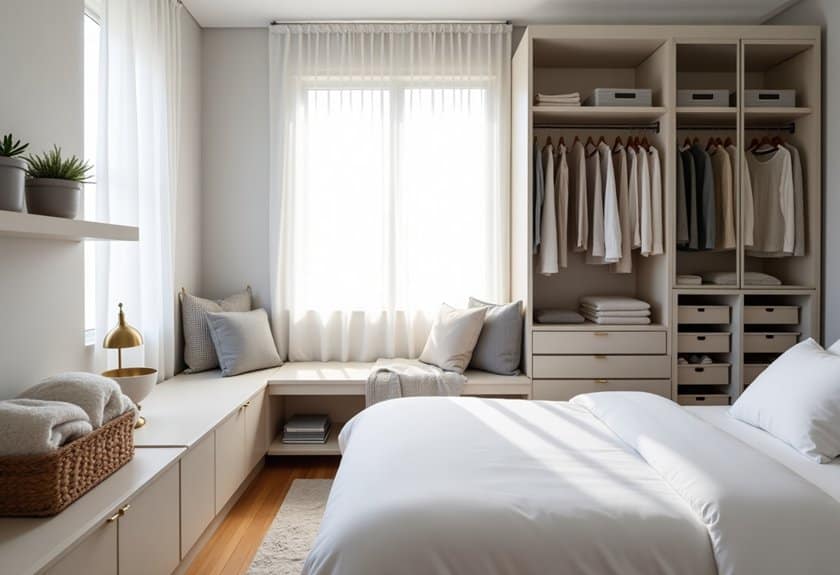Your bedroom should be your personal haven, but let’s be honest – keeping it organized can feel like an uphill battle! I’ve spent years perfecting these organization strategies, and now I’m excited to share them with you. From clever wall storage that’ll double your space to life-changing closet systems that’ll transform your morning routine, these 10 practical tips will help you create the peaceful, clutter-free sanctuary you’ve always wanted. Ready to unlock your bedroom’s full potential?

Maximize Vertical Space With Wall-Mounted Storage
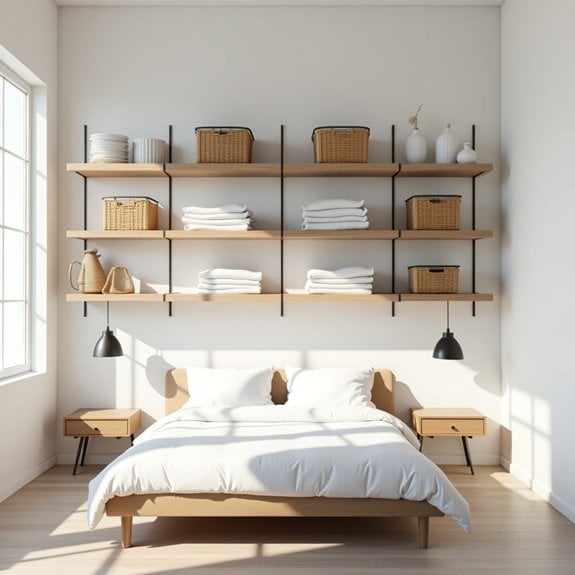
Making the most of vertical space is crucial in any room, especially in homes where square footage is limited. Wall-mounted storage solutions can transform unused wall space into valuable storage areas, effectively doubling or tripling your storage capacity without consuming precious floor space.
Wall storage not only helps declutter your living space but also creates an organized, visually appealing environment. By lifting items off the floor and arranging them vertically, you can improve room flow, make cleaning easier, and create designated spaces for different categories of belongings.
Required Items:
- Stud finder
- Level
- Drill and drill bits
- Screwdriver
- Wall anchors
- Mounting brackets
- Floating shelves
- Pegboards
- Wall-mounted organizers
- Measuring tape
- Pencil
- Storage bins or baskets
- Labels
- Cable ties
Start by surveying your walls and identifying sturdy mounting points using a stud finder. Measure and mark your intended storage locations, ensuring proper spacing between units and appropriate heights for easy access. Install wall anchors where needed, and mount your chosen storage solutions securely, beginning with larger units like shelves or pegboards.
Create zones for different items, such as frequently used items at eye level and seasonal items higher up. When arranging items on your wall-mounted storage, place heavier items on sturdy shelves closest to wall studs. Utilize storage bins and baskets to group similar items together, and implement a clear labeling system.
Consider the visual impact of your arrangement, creating balanced displays that are both functional and aesthetically pleasing.
Additional Tips: Regularly assess the weight capacity of your mounted storage solutions and periodically check that all mounting hardware remains secure. Rotate seasonal items as needed, and maintain clear pathways below wall-mounted storage.
Consider installing adjustable systems that can be modified as your storage needs change, and always leave some empty space for future items or rearrangement flexibility.
Create a Strategic Closet System
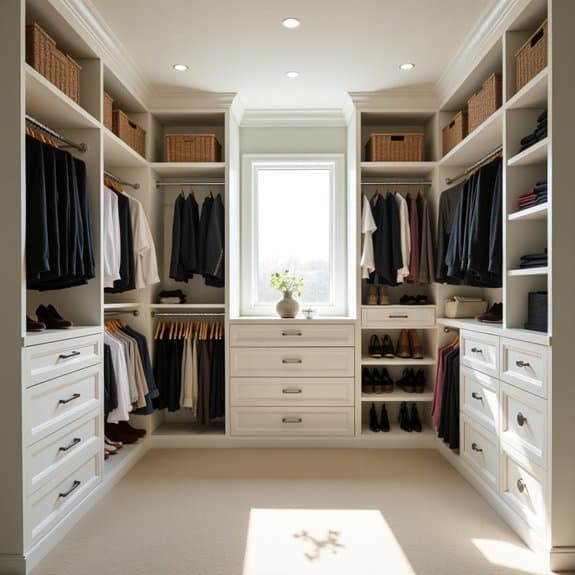
A well-organized closet system serves as the foundation for an efficient daily routine and a clutter-free bedroom. Rather than wasting precious minutes searching for clothing or accessories, a strategic closet system allows you to quickly locate items and maintain order throughout your space.
Creating an effective closet organization system not only maximizes available storage space but also helps preserve the quality of your belongings through proper storage methods. When items have designated spaces and are stored appropriately, they remain in better condition and are more likely to be used regularly.
Required Items:
- Clothing rod(s)
- Hanging organizers
- Storage boxes
- Shelf dividers
- Drawer organizers
- Labels
- Hangers (uniform style)
- Storage bins
- Shoe racks
- Clear storage containers
Start by removing everything from your closet and sorting items into categories: everyday wear, seasonal clothing, special occasions, and accessories. Install adjustable rods at varying heights to maximize vertical space, with frequently used items at eye level. Position shelving units strategically to accommodate folded items and storage boxes.
Create designated zones within your closet: hanging clothes, folded items, shoes, and accessories. Implement the zone system by hanging clothes by category and color, with work attire separate from casual wear. Use shelf dividers to prevent stacked items from toppling and drawer organizers to compartmentalize smaller items.
Install hooks or specialized organizers on the back of the closet door for accessories, belts, or scarves. Position shoes in a visible, accessible area using tiered racks or clear boxes.
Additional Tips: Maintain your closet system by conducting seasonal reviews, removing items you haven’t worn in the past year. Consider using space-saving hangers and implementing a “one-in-one-out” rule when acquiring new items. Keep frequently used items in prime real estate areas and store seasonal items in clearly labeled containers on upper shelves or under-bed storage.
Utilize Under-Bed Storage Solutions

Under-bed storage represents one of the most underutilized spaces in any bedroom. This often-forgotten area can provide valuable square footage for storing seasonal items, extra bedding, clothing, or rarely used possessions. When properly organized, under-bed storage can help maintain a clutter-free living space while keeping important items easily accessible.
Making the most of this space requires strategic planning and the right storage solutions. An organized under-bed area not only maximizes storage capacity but also protects items from dust and helps maintain a clean, organized bedroom environment. With proper containers and a systematic approach, this space can become an efficient extension of your storage system.
Required Items:
- Under-bed storage containers or boxes
- Bed risers (if needed)
- Measuring tape
- Labels and marker
- Dust-proof covers
- Storage bags for soft items
- Drawer organizers or dividers
- Vacuum storage bags
- Casters or wheels (optional)
Start by measuring the available space under your bed, including height, width, and depth. Clear the area completely and vacuum thoroughly. Sort items into categories: seasonal clothing, extra bedding, shoes, or memorabilia.
Select appropriately sized containers that maximize the space while allowing easy sliding in and out. Consider containers with wheels for heavier items or those accessed frequently. Place items used most often toward the front for easy access, with less-used items toward the back.
Label all containers clearly on multiple sides for easy identification. Use vacuum storage bags for soft items like blankets or winter clothing to maximize space. If using multiple containers, create a simple map or inventory of what’s stored where, especially for items stored at the back.
Consider adding bed risers if additional height is needed for larger storage containers. For optimal organization maintenance, conduct seasonal reviews of stored items, rotating them as needed. Use dust-proof covers or containers to protect stored items, and avoid storing anything directly on the floor without protection.
Consider adding a bed skirt to conceal storage while maintaining easy access. Regular cleaning and reorganizing will help maintain the system’s efficiency and prevent the space from becoming a forgotten dumping ground.
Declutter Your Nightstand With Purpose
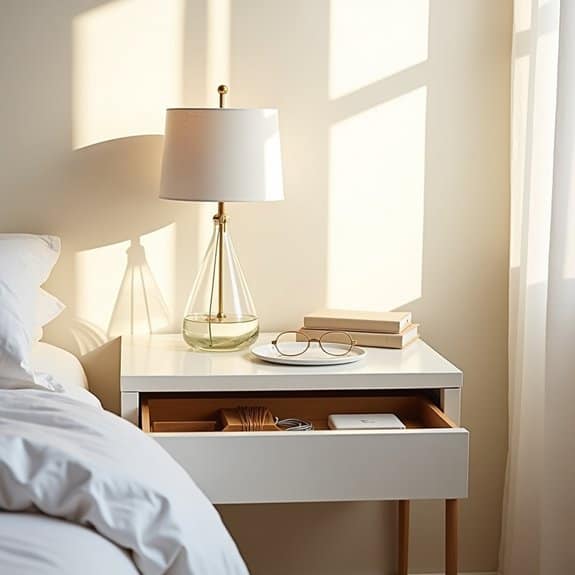
A well-organized nightstand is essential for creating a peaceful bedroom environment and promoting better sleep habits. When your bedside area is cluttered with unnecessary items, it can create visual chaos and make it difficult to find important items when you need them most, especially during nighttime hours.
An organized nightstand serves as a functional command center for your bedtime and morning routines. By maintaining only essential items within arm’s reach, you can reduce stress, improve sleep quality, and start each day with clarity and purpose rather than searching through accumulated clutter.
Required Items:
- Small drawer organizers or dividers
- Storage container for cables
- Cleaning cloth
- Small trash bag
- Disinfecting wipes
- Box for items to relocate
- Bedside lamp
- Phone charging station
- Small notepad and pen
Start by removing everything from your nightstand surface and drawers. Clean all surfaces thoroughly with disinfecting wipes. Sort items into three categories: essential daily items, occasional-use items, and items that belong elsewhere.
Essential items typically include a lamp, phone charger, current book, reading glasses, and water bottle. Place these items back on the surface, positioning frequently used items closest to your reach.
For drawer organization, use small organizers or dividers to create designated spaces for specific items. Store occasional-use items like medicines, tissues, or personal care products in the top drawer, arranged by frequency of use. Reserve lower drawers for items needed less frequently, such as extra charging cables or reading materials.
Additional Tips:
Maintain your organized nightstand by implementing a weekly quick cleanup routine. Remove any accumulated items that don’t belong, wipe down surfaces, and reassess the necessity of stored items.
Consider using a small tray on top to corral loose items and maintain a neat appearance. Replace bulky items with smaller alternatives when possible, and regularly evaluate whether stored items truly need to be within arm’s reach during the night.
Implement the One-In-One-Out Rule
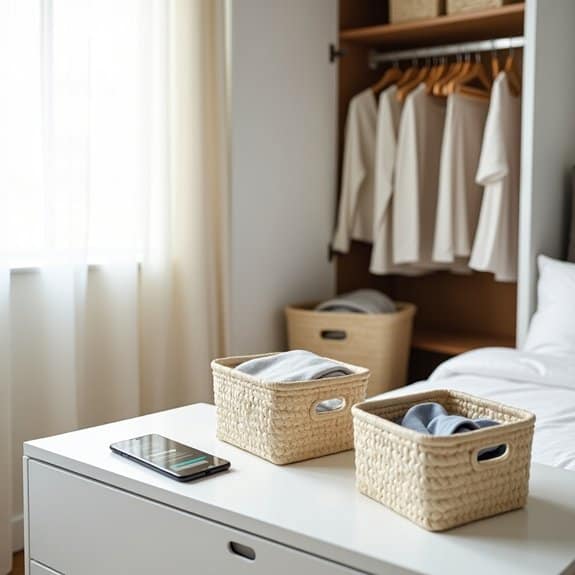
The One-In-One-Out Rule stands as a fundamental principle in maintaining an organized and clutter-free living space. This simple yet powerful approach prevents the gradual accumulation of items that often leads to overcrowded rooms, stuffed closets, and chaotic storage areas.
By establishing this systematic approach to acquiring new items, you create a sustainable way to manage your possessions while maintaining order in your home. The rule not only helps control clutter but also promotes mindful consumption, encouraging thoughtful decisions about purchases and preventing impulsive buying habits.
Required Items:
- Donation boxes or bags
- Trash bags
- Labels or marker
- Storage containers
- Inventory list (optional)
- Camera (optional)
The implementation process begins by conducting an initial assessment of your current belongings in each category (clothing, books, electronics, etc.). When acquiring a new item, immediately identify a similar item to remove from your collection. Place the outgoing item in a designated donation box or disposal bag, depending on its condition.
Create a staging area for outgoing items, and establish a regular schedule for dropping off donations or disposing of items properly. For successful maintenance of this system, document your decisions by maintaining a simple inventory list or taking photos of items entering and leaving your space.
Consider creating specific zones for different categories of items, making it easier to identify excess and maintain balance. When shopping, carry photos of your current items to avoid duplicate purchases and ensure new acquisitions truly add value to your space.
Additional Tips: Establish monthly review sessions to ensure compliance with the rule and adjust as needed. Share your commitment with family members or roommates to gain support and cooperation. Consider implementing a waiting period before new purchases to prevent impulse buying and maintain the system’s integrity.
Use clear containers or visible storage solutions to maintain awareness of your inventory levels.
Design a Functional Drawer Organization System
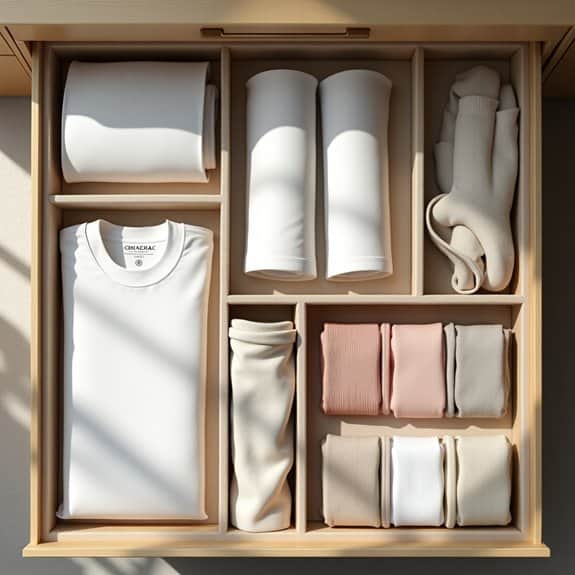
A well-organized drawer system serves as the foundation for an efficient and stress-free living space. When drawers are properly organized, you can locate items quickly, maximize storage space, and maintain order in your daily routine.
Whether in your bedroom, kitchen, or office, organized drawers eliminate the frustration of rummaging through cluttered spaces.
Creating a functional drawer organization system not only saves time but also preserves the condition of your belongings. When items have designated spaces and proper containment, they’re less likely to become damaged or lost.
This systematic approach to storage transforms chaotic drawers into streamlined, purposeful spaces that enhance your productivity and peace of mind.
Required Items:
- Drawer dividers
- Small containers or bins
- Measuring tape
- Labels and label maker
- Drawer liner
- Scissors
- Storage boxes (various sizes)
- Clear plastic organizers
- Drawer pulls or handles
- Shelf liner (non-slip)
Start by removing everything from the drawers and thoroughly cleaning the interior surfaces. Measure each drawer’s dimensions carefully, accounting for depth, width, and height.
Sort items into categories based on frequency of use and function, discarding anything broken or unnecessary. Select appropriate-sized dividers and containers that fit your drawer measurements precisely.
Install non-slip liner at the bottom of each drawer to prevent items from sliding. Position drawer dividers to create distinct sections based on your categorized items.
Place frequently used items toward the front of drawers for easy access. Arrange containers and organizers within the designated spaces, ensuring they fit snugly without forcing or overcrowding.
For optimal long-term success, implement a labeling system that clearly identifies each section’s contents. Regularly assess the organization system’s effectiveness and adjust compartments as needed.
Consider implementing a quarterly maintenance schedule to review contents, clean organizers, and maintain the system’s functionality. This proactive approach prevents reverting to cluttered, disorganized spaces.
Set Up a Seasonal Rotation Schedule

Implementing a seasonal rotation schedule is essential for maintaining an organized and clutter-free living space throughout the year. By systematically rotating items based on the seasons, you can maximize storage space, reduce visual clutter, and ensure easy access to items when they’re needed most.
A well-planned seasonal rotation system prevents the accumulation of unnecessary items in your active living space while protecting off-season belongings from damage or deterioration. This organizational approach also provides regular opportunities to assess, declutter, and maintain your possessions as you transition between seasons.
Required Items:
- Storage containers (clear bins preferred)
- Labels and marker
- Storage bags (vacuum-sealed optional)
- Inventory sheets
- Calendar
- Climate-controlled storage space
- Basic cleaning supplies
- Garment rack
- Storage shelving units
Start by dividing your belongings into seasonal categories: spring/summer and fall/winter. Create an inventory list for each season, including clothing, decorations, sports equipment, and outdoor gear. Thoroughly clean all items before storage, ensuring they’re completely dry to prevent mold growth.
Pack items in clearly labeled, weather-resistant containers, using vacuum-sealed bags for fabric items to maximize space. Designate specific storage areas for off-season items, ensuring they’re protected from moisture, pests, and extreme temperatures.
Mark your calendar with transition dates, typically scheduling rotations during the last month of each season. During each rotation, inspect items for damage, create donation piles for unused pieces, and update your inventory lists.
To optimize your seasonal rotation system, maintain a detailed log of stored items’ locations and establish a cleaning routine for both stored and active items. Consider implementing a “one-in-one-out” rule when acquiring new seasonal items to prevent overflow, and regularly reassess your storage needs as seasons change.
Keep frequently used items accessible year-round, and store rarely used pieces in less convenient locations.
Choose Multi-Purpose Furniture Pieces
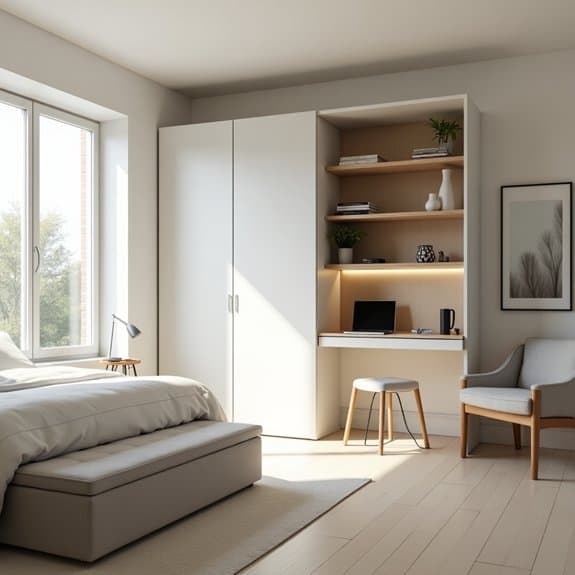
Living spaces are becoming increasingly compact, making it essential to maximize every square foot of available space. Multi-purpose furniture pieces serve as the cornerstone of efficient room organization, offering versatile solutions that adapt to various needs while minimizing spatial requirements.
The strategic selection and placement of dual-function furniture can transform a cluttered space into an organized, functional environment. These pieces not only save space but also reduce the total number of furniture items needed, creating a more streamlined and aesthetically pleasing room while maintaining full functionality.
Required Items:
- Measuring tape
- Floor plan or room layout sketch
- Note-taking materials
- Camera for room documentation
- Budget plan
- Storage assessment checklist
- Furniture catalog or research materials
Selecting and organizing multi-purpose furniture requires careful planning and execution. Start by assessing your room’s primary functions and identifying opportunities where furniture pieces can serve multiple purposes.
Consider options like ottoman storage benches, murphy beds with built-in desks, expandable dining tables, or modular seating with hidden storage compartments. Position these pieces strategically, ensuring they can easily transition between functions without disrupting the room’s flow.
Create designated zones within the space where furniture can serve multiple purposes without competing with other activities. Map out specific placement locations that allow easy access to both primary and secondary functions of each piece.
For example, a convertible sofa bed should be positioned with adequate clearance for both seating and sleeping configurations. Ensure storage components are easily accessible and maintain clear pathways around multi-functional pieces when in use.
To maximize the effectiveness of multi-purpose furniture, regularly evaluate and adjust the arrangement based on usage patterns. Consider seasonal needs and varying activities when selecting pieces, and maintain flexibility in your layout to accommodate changing requirements.
Keep instruction manuals accessible for convertible pieces and regularly inspect mechanisms to ensure smooth operation and longevity of dual-function items.
Establish Daily Organization Habits
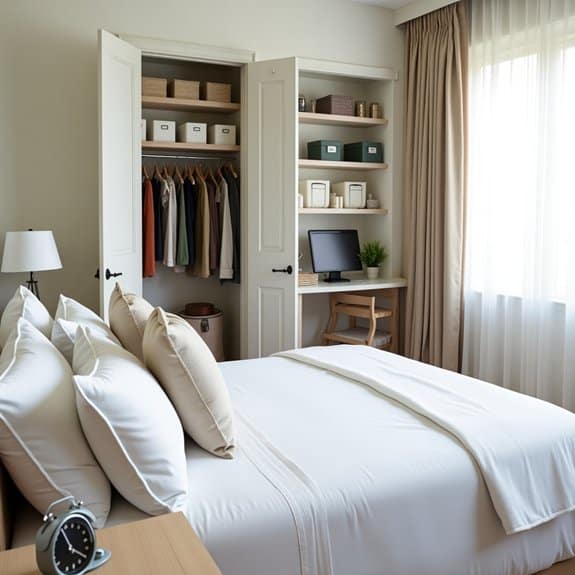
Developing daily organization habits is crucial for maintaining a clutter-free and functional living space. When we incorporate organizational tasks into our daily routine, they become second nature rather than overwhelming chores that pile up over time. This systematic approach prevents the need for major cleanup sessions and helps maintain the harmony of your living space continuously.
Creating and maintaining daily organization habits can significantly reduce stress levels and increase productivity. A well-organized space saves time by eliminating the need to search for items, reduces decision fatigue, and creates a more peaceful environment. These habits, once established, become an effortless part of daily life and contribute to long-term organization success.
Required Items:
- Daily planner or checklist
- Storage containers
- Labels
- Cleaning supplies
- Designated bins or baskets
- Timer
- Storage solutions for daily items
- Calendar or scheduling system
Start by identifying 3-5 key organization tasks that need to be performed daily, such as making the bed, clearing surfaces, and putting away items after use. Assign specific times for these tasks, preferably incorporating them into existing routines like morning or evening rituals.
Break down larger organizational tasks into smaller, manageable daily actions that take no more than 5-10 minutes each. Implement a “one-in-one-out” rule for daily items, ensuring that anything taken out is returned to its designated spot immediately after use.
Create stations or zones for daily activities, keeping necessary items within reach and establishing clear homes for frequently used objects. Set up a daily reset routine for each room, scheduling 10-15 minutes at the end of the day to return items to their proper places and prepare for the next day.
Additional Tips:
Set reminders on your phone for daily organization tasks until they become habitual, use the “two-minute rule” (if a task takes less than two minutes, do it immediately), and maintain a decluttering basket in each room for items that need to be relocated or disposed of.
Consider implementing a weekly review of your organizational systems to adjust and improve habits as needed, and celebrate small victories to maintain motivation and momentum in your organization journey.
Master the Art of Folding and Storage Techniques
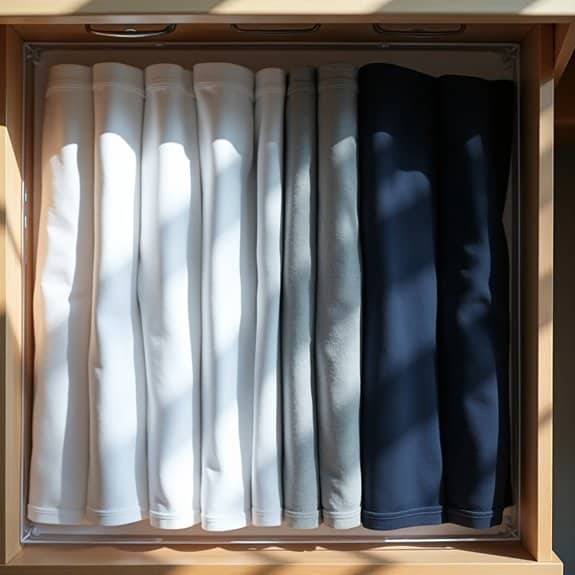
Proper folding and storage techniques form the foundation of an organized living space. When clothes and items are folded correctly and stored efficiently, they not only take up less space but also remain easily accessible and maintain their quality for longer periods. This systematic approach to organization can transform cluttered drawers and overcrowded closets into functional, aesthetically pleasing spaces.
The impact of mastering folding and storage extends beyond mere tidiness. Well-organized spaces reduce daily stress, save time when searching for items, and create a more peaceful environment. Additionally, proper folding techniques can eliminate the need for ironing and help preserve the fabric quality of clothing and linens.
Required Items:
- Drawer dividers
- Storage boxes
- Shelf organizers
- Hanging rod organizers
- Clear storage containers
- Labels and label maker
- Slim hangers
- Folding board (optional)
Start by sorting items by category and removing anything damaged or unused. For clothing, implement the vertical folding method: fold items into rectangles, then fold again until they can stand upright. This technique allows for visible storage and easy access. Place frequently used items at the front of drawers or at eye level in closets. For delicate materials, use tissue paper between folds to prevent creasing.
Store seasonal items in clear, airtight containers with detailed labels. Utilize vertical space by installing additional shelving or hanging organizers. Maximize drawer space by using dividers to create designated sections for different types of items. Roll items like scarves, belts, and ties to prevent wrinkles and save space.
To maintain this organization system, perform weekly mini-audits of your storage spaces. Remove items that don’t belong, refold anything that has become disheveled, and adjust dividers as needed. Consider installing motion-sensor lights in dark closet corners and using humidity absorbers to protect stored items. Rotate seasonal items twice yearly to ensure everything remains accessible when needed.

